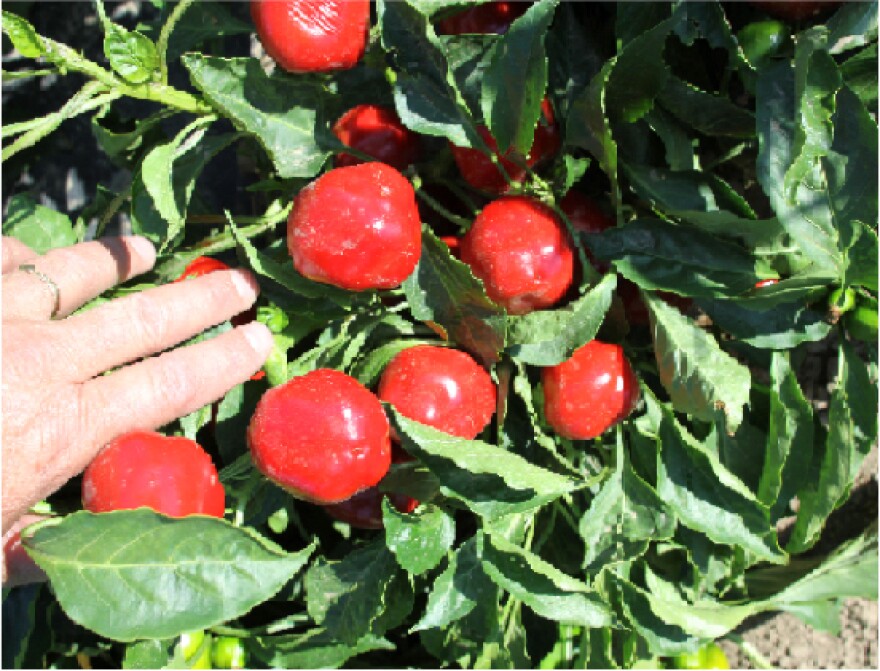A line of chefs bend over electric grills on a warm Saturday afternoon during the 2014 Denver Chili Fest, at LuLu's Farm in Brighton, Colorado. They make quick motions, layering their ingredients. Tortilla. Cheese. Chile. Tortilla.
The cooks slap the green chile quesadillas on the grills, close the lids, and take a breath, while the chiles and cheese melt into a mingled mass of spicy goodness. Don Stump, an independent chef volunteering time at the grill, gestures to his peppers.
"These are Dynamite, the other ones are Espanolas," he explains. "Those are hot. These are hotter."
As soon as a quesadilla pops off the grill, it's sliced into eighths. And devoured. Green chile aficionados from the Denver metro area swarm the tables, snagging a pie-shaped slice and popping it into their mouth. It turns out, Coloradans are pretty crazy for green chile.
While Colorado produces far fewer chiles than New Mexico, a state famous for chiles, the Centennial State's minor obsession with the spicy green substance known as green chile is growing, say farmers and eaters.

In late summer and early fall, street corners and plant nurseries across the Front Range metro area transform into minor production facilities. Any stretch of open asphalt is fair game for a black metal roaster rolled off the pickup, a popup tent covering produce boxes and bags for fresh-roasted bushels.
Many of these chiles come from New Mexico. But Colorado also has a rich history of chile growing, if at a smaller scale. The Pueblo Hot, or Mira Sol, has been grown in the area around Pueblo for generations. As interest in locally grown food spreads, Colorado chile growers are seeing more demand for their crop.
Anita Edge, who runs the Denver Green Chili website, lists varieties popular with Coloradans – the mouth-busting Dynamite, and the LuLu's Superhot, developed locally. Chubbies – "cute, long, and fat," while not developed here, were revived by local farmers, she said.
Colorado's one chile breeding professional is Colorado State University's Mike Bartolo, who, for the last 20 years, has been quietly working on developing the next great Colorado green chile. His 2005 release, the Mosco chile, may now be the most popular in the state. The spicy green chile, like other Pueblo varieties, grows upright, face to the sun, and is known for its larger size and thick skin.
"The whole purpose of this is we are striving to find ways to make unique crops that are adapted here to Colorado, particularly here in the Arkansas valley," said Bartolo, who only devotes a small portion of his time to chile breeding.

Now, Bartolo is getting ready to release a new type of chile -- the Pueblo Popper. It's squatter, milder, and good for stuffing.
It's great timing, said Shane Milberger, a Pueblo-based chile farmer who grows about 50 acres of chiles – a number that is growing year by year, he said.
"Everybody is excited about trying something new. We want to be the first to try it."
Milberger said the original Pueblo chile "addiction" was pretty localized at first, but it's spread north to Denver and beyond. It's driven by a demand for more local food, he thinks. He's also seen Pueblo chiles gaining in popularity outside of Colorado.
"We have people from New Mexico, Texas, Oklahoma, Kansas, they drive here and pick up their chiles," he said. "Forget about Hatch," he laughed, casting a mild jab at the best-known green chiles in the country.
While for some, Hatch defines green chile, more than a few Colorado green chile enthusiasts say home grown is best.
Ted Gutierrez, a resident of Thornton, has been going to the same farm to get chiles for 40 years – the farm, formerly Dean's, now LuLu's, the site of the Denver Chili Festival – has changed names, but the local chiles have always been delicious, Gutierrez said.
"I've been to those festivals in New Mexico," Gutierrez said. "You don't have to go that far for the chile."
Like many of the green chile lovers at the Denver festival, Gutierrez said the best green chile is pretty simple: lots and lots of chiles, and pork.
The best chile of all? The one his grandma made.







